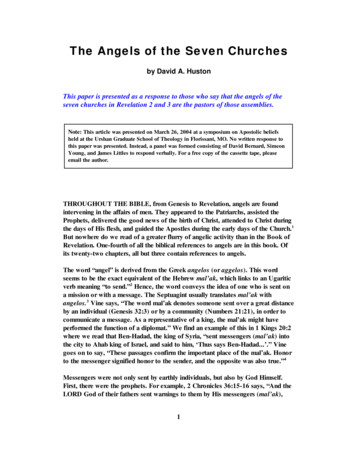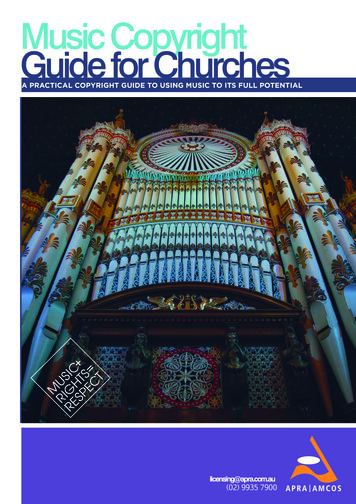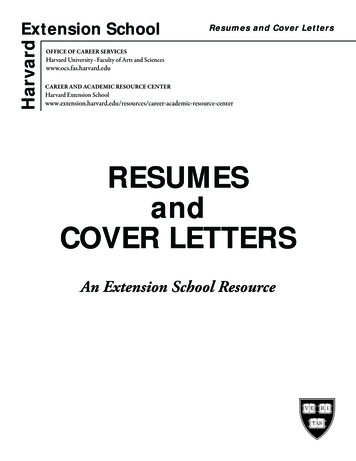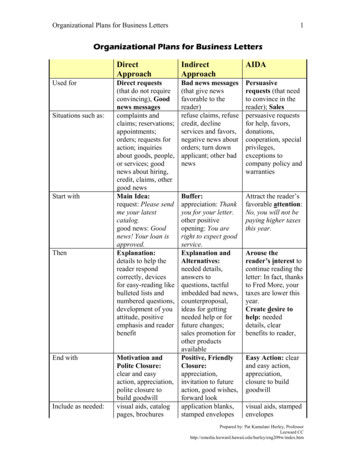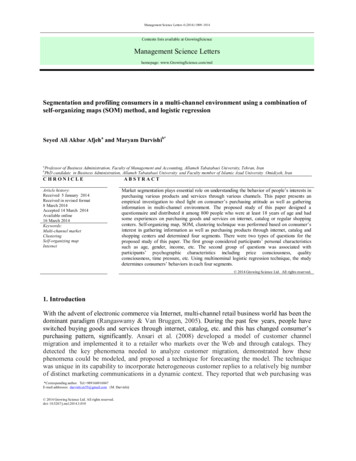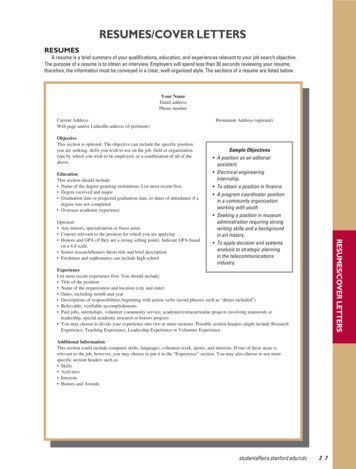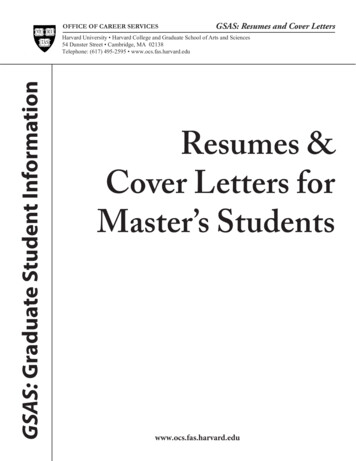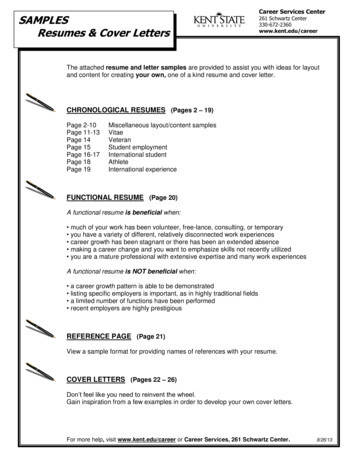
Transcription
Seven Letters to Seven Churches“You Are Here”(Revelation 2 and 3)
IntroductionA cartoon in an old Readers’ Digest showed a confused looking hunter, obviously lostin the woods, puzzling over a sign with an “X” marking a spot. Next to the “X” was theexplanation “You were here. Now you’re lost.”No road map can help you find your destination if you don’t know where you are inrelationship to the map. If we are to “know the way,” the first item on the agenda must beto correctly identify our own position in relationship to the guiding device.The church of the 20th Century seems to be traveling at a very rapid pace. But whereis it going? The Bible has already laid out a “road map” for the church in the second andthird chapters of Revelation. For centuries, Christians have attempted to identifythemselves, and their church, in relation to the letters written to seven churches in thisportion of the Bible.As is so often the case with God’s divine prophecies, however, up until recent times ithas been rather difficult to understand all that is contained in this passage and itsmiraculous picture of church history over the course of time – simply because so much ofthat time was still future. Today, however, we can look at these letters and hold themagainst the light of church history from the day of Pentecost to our present time. And ifwe will do that, it is utterly amazing what a picture of the present day church appears.By way of confirmation, or as icing on the cake if you will, the messages can befurther compared with the seven prophecies of the kingdom as spoken by Christ inMatthew 13. Again, a startling correspondence between these prophecies (as they areparables related to future events), and the progression that is evidenced in Revelation 2and 3.Finally, it must be stated that this is being written “by request.” I have presented thismaterial in several small meetings, and each time I have had someone ask me where theycan “get this material.” Although I make no claim to originality, I don’t know of anysimilar published dissertations.The basic premise is certainly not original. The historical approach to interpreting theletters to the seven churches in Revelation 2 and 3 can be found in the notes on thosechapters in the Scofield Reference Bible. The same approach is taken in Watchman Nee’sThe Orthodoxy of the Church (Living Stream Ministry, publisher), although Brother Neelived in a time when the final church period was a little more difficult to anticipate than itis today. Timothy LeHaye uses the same method of interpretation in his book RevelationUnveiled (Zondervan). A “Briefing Package” on the Seven Letters to the Seven Churchesby Chuck Missler, which also views the seven churches as representing seven periods ofchurch history, can be obtained by contacting Koinonia House, PO Box D, Coeurd’Alene, ID 83816 (1-800-KHOUSE-1) www.khouse.org. While all of these works are tobe recommended, none of them have looked closely at the recurring themes ofNicolaitanism and amillennial theology and the results they have had for the churchthroughout the ages.
Other suggested reading for the subject at hand includes classics like Foxe’s Book ofMartyrs and The Pilgrim Church by E.H. Broadbent (Marshall Pickering, publisher), andmore recent works such as Climb the Highest Mountain by Gene Edwards (Seedsowers),and A Woman Rides the Beast by Dave Hunt (Harvest House).As for the “rights” to this material, anyone who wishes may copy, print or otherwise distribute thecontents of this PDF file. This PDF file is for on-line viewing. If you would like plain text files ofthe contents, send a request to tded@hotmail.com, along with any other comments or suggestionsyou may have.In Christ,A brother in Kansas City
A word about interpreting Scripture One must always be cautious when attempting to interpret divinely inspired Scripture,whether for the purpose of teaching others, or simply informing or amusing one’s self.Those of us who believe that every word of Scripture was given by inspiration of Godmust also keep in mind that each word was given for a specific purpose – it is what Godmeant to say. That is, there was something specific God intended to communicate by thewords He chose to use.Nevertheless, it is also obvious that any specific passage of Scripture can be subject tovarious methods of interpretation – literal or figurative, doctrinal or spiritual.No one passage of Scripture has been subject to so many different methods ofinterpretation as has the Book of Revelation, including the letters to seven churches foundin chapters two and three. In this article, I am attempting to arrive at the “doctrinal”interpretation of this passage. That is to say, the specific, primary true information theLord intended to impart that could not be known apart from divine revelation. That doesnot mean that these passages could not be found valuable if put to a differentinterpretation, or even that God could not use that interpretation to bless and edify.In the case of the letters to the seven churches, they have often been interpreted a)historically, b) spiritually, c) doctrinally, and d) prophetically. The historicalinterpretation explains the passage in relation to the church named in the specific letter asit existed at the time the letter was recorded by the Apostle John at the close of the 1stCentury. By employing a “spiritual” application, every Christian can look for the traitsassociated with each church in his or her individual life, and thereby apply theencouragement and admonitions given by the Lord to these churches to his or her ownspiritual walk. Doctrinally, the passage has been seen as having something to say tochurches today. That is, all of the characteristics of the churches of Revelation exist tosome extent or another in the various churches and congregations of our own time.In this article, however, we will look only at the “prophetic” interpretation, as it willbecome apparent that the letters to the churches have been given in an order that exactlyparallels the development of church history from the day of Pentecost to the present dayand on to the end of the age. For this reason, I consider the prophetic interpretation to bethe doctrinal interpretation as well. That is, the primary, true reason the Scripture wasgiven to us in the first place. That does not mean that much good cannot be achieved bystudying the passages in the light of the other methods of interpretation mentioned.Finally, there is the issue of translations. That is always an issue these days. That is anissue that I will perhaps cover in another, separate article. Suffice it to say, for thepurposes of this study all Scripture will taken from the Authorized Version of the Bible(more recently – and more commonly – referred to as the King James Version or, simply,King James Bible). This should not be construed to mean that I am ignorant of theexistence of other versions of the Bible or their readings. It simply means that I believethe AV supplies the correct reading and is exactly what God intended for us to read andbelieve.
Simplified Timeline of Church HistoryShowing Major Events That Changed ChristianityThe “Brethren Movement”AD 1840Birth of Modern Day“Fundamentalism”Restoration of DispensationalPremillenialismConstantineAD 300Paganization ofChristianityAD 500PentecostAD 40OfficialPersecutionAD 150 – AD 300AD 1000Gregory I(First Pope)AD 600Establishment ofRoman Catholic ChurchAD 1500Luther, Knox, CalvinReformationAD 1500Establishment ofModern Day �1900The Dark Ages, or “Middle Ages” – referring tothe period of time the Roman Catholic Churchruled the Western worldThis chart represents an admittedly over simplified timeline of church history. Hopefully, any child who hasgone to Sunday School would be able to think of a number of people and events that could be included on such atimeline.Not every event one could think of resulted in a drastic, dramatic change in the organization, practice, and
one seat and we are all seated together in one body. May we give the Lord glory andhonor here and now by practicing the same on earth!
EphesusHomeUpArticlesResourcesLinksContactThe Church at EphesusThe Apostolic Church Period(AD 40 150)Unto the angel of the church of Ephesus write; These things saith he that holdeth the sevenstars in his right hand, who walketh in the midst of the seven golden candlesticks; I knowthy works, and thy labour, and thy patience, and how thou canst not bear them which areevil: and thou hast tried them which say they are apostles, and are not, and hast found themliars: And hast borne, and hast patience, and for my name's sake hast laboured, and hastnot fainted. (Revelation 2:1—3)the first period of church history began on the day of Pentecost. The Holy Spirit visited the12 Apostles of the Lord as they gathered with 100–some other brothers and sisters in theLord in an upper room in Jerusalem. That visitation resulted in a flurry of evangelistic activity that saw the church being added to daily—thousands of new believers at a time.Persecution by the Jewish leaders caused the Good News to be dispersed all over Judea andeven to Syria. Churches were established throughout the region, comprised of Jewishbelievers all.After his conversion on the road to Damascus, where he was headed to round up those whofled the persecution in Jerusalem, Paul and his fellow workers headed out from Antioch andtraveled Asia Minor, or modern Turkey and southern Europe, and established new churchesas they went. Paul took the gospel as far as Rome in Italy, even though it appears from hisletter to this church that someone had preceded him with the Good News, as a great numberof gatherings were already oper-ating there (see Romans 16).So we see God had ordained that the church be under the tutelage of Apostles (Ephesians2:20). The only “scriptures” known at the time (see Acts 17:11 and II Tim. 3:15-16) werethe Old Testa-ment writings. The New Testament was, of course, still being written. Evenafter John penned his final epis-tle, it took some time for the New Testament books tocirculate and gain acceptance. When they did, it was on the basis of apostolic authorshipthat they were included in the canon.However, not everyone who claimed to be “sent by God” was a true Apostle. In His letterto the believers of this age, the Lord Jesus commends them on their discernment and theirability to know true apostles from those He calls liars. It was this special grace thatfile:///C /My%20Documents/My%20Webs/New%20MCry%20Site/Seven Letters/church at ephesus.htm (1 of 5)4/29/2004 7:57:22 AM
Ephesusprevented “the gospel of Thomas” and First Clement from being included in our NewTestaments today.Nevertheless I have somewhat against thee, because thou hast left thy first love. Remembertherefore from whence thou art fallen, and repent, and do the first works; or else I willcome unto thee quickly, and will remove thy candlestick out of his place, except thourepent. (Revelation 2:4,5)You have probably heard many sermons based on this verse exhorting you not to lose your“first love” for Jesus. While this is a fine spiritual application of Revelation 2:4, in contextit would appear that the Lord is referring to an entirely different issue in this first period ofchurch history.For this is the message that ye heard from the beginning, that we should love oneanother. (I John 3:11)While the Lord commends this church for its discernment and faithfulness, He admonishesthem for “losing their first love,” or the kind of brotherly love that was expressed amongthem in the beginning. This is understandably an “occupational hazard” for those who arezealous to safeguard doctrinal purity in the church.The church or Body of Christ today is split and fractured into literally countlessdenominations, fellowships, associations and the like, so many of which will allow nofellowship with a brother of another denominational stripe. Oftentimes, the differences overwhich these factions separate are so trivial as to be almost comical. The churches that areassociated with these factions and “schisms” as they are referred to in the Bible, apparentlytake little stock of Romans 12:16; I Corinthians 1:10-13; or I Peter 3:8. And yet they allclaim to be followers of the One who said, “By this shall all men know that ye are mydisciples, if ye have love one to another” (John 13:35).The Lord did not intend for HIS church, that is His BODY, to be split and divided overpractice, preference, or even doctrine. There is ONE BODY, and it is NOT divided, anddivisions men recognize are artificial and man-made.And more to the point, they invariably are the result of a lack of love for the brethren, and alack of revelation of what the Body of Christ truly is. Let us set our hearts and minds tolove the brethren—all those who are in Christ—regardless of any differences of race, socialstanding, denominational affiliation, pet doctrine, or favorite Bible version. Let usrecognize division in the Body as the ploy of the enemy, and let us stand against it, andrefuse to practice it, at all costs. Let us owe no man any-thing, but to love him as a brotherin Christ.There is much more that could be said in this regard, but we move on file:///C /My%20Documents/My%20Webs/New%20MCry%20Site/Seven Letters/church at ephesus.htm (2 of 5)4/29/2004 7:57:22 AM
EphesusBut this thou hast, that thou hatest the deeds of the Nicolaitans, which I also hate.(Revelation 2:5)The Lord here makes an incredibly strong statement. He mentions a sect, or group ofpeople within the church whom he refers to as the Nicolaitans, and then states inunequivocal terms that He hates the things they do. We will see that later on, the deeds, orthe things they do, will become a doctrine or teaching of the church (Rev. 2:15). But eventhough the church adopts these practices and even incorporates them into the doctrines ofthe church, the Lord contin
is today. Timothy LeHaye uses the same method of interpretation in his book Revelation Unveiled (Zondervan). A “Briefing Package” on the Seven Letters to the Seven Churches by Chuck Missler, which also views the seven churches as representing seven periods of church history, can be obtained by contacting Koinonia House, PO Box D, Coeur
